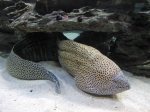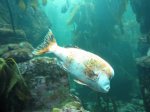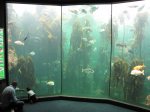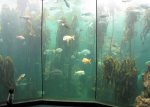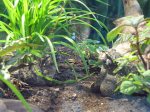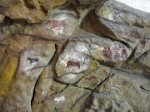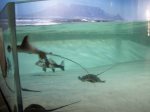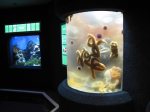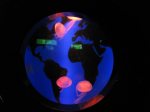Back in early April I traveled from my home in Cape Town, South Africa to the Eastern Cape, South Africa. I went for a long weekend to visit my husband in Grahamstown. My husband periodically spends several weeks in Grahamstown as he is working (part-time) on his masters degree in Exploration Geology at Rhodes University. I also visited the Eastern Cape back in December. I’m really enjoying exploring the Eastern Cape. I look forward to more visits there in the future and also to sharing some tidbits about my Eastern Cape travels with you here on Georneys. I’ll start by telling you about the giant pineapple. Yes, the giant pineapple.
Unfortunately, it poured down rain all weekend during my April visit to the Eastern Cape. However, my husband and I didn’t let the rain stop us from doing some sightseeing. On Saturday we drove from Grahamstown down to Port Alfred, and we stopped in the little agricultural town of Bathurst along the way.

As we were driving along through Bathurst, I was quite surprised to hear my husband say, “Oh, look. There’s the giant pineapple.”
I said, “The what?” and then nearly drove off the road (not really, but my attention was diverted for a moment) when this giant pineapple came into view:

Of course, we had to stop and take a look at what is known as “The Big Pineapple”. Located on a pineapple farm and experimental station, The Big Pineapple is a 16.7 m tall pineapple-shaped building that has three floors. The first floor is a gift shop where you can buy pineapples, various pineapple food items (dried pineapples, jellies, chutneys, etc.), and all sorts of pineapple-themed souvenirs (t-shirts, bags, tea towels, figurines, etc.– we bought a pineapple-decorated sugar bowl). The second floor is a museum with some general information about pineapples and the history of pineapple farming in South Africa. The third floor has a TV showing a movie about pineapples and an observation deck, where you can enjoy the view, which includes fields of growing pineapples. On clear days, you can apparently see the Indian Ocean in the distance. On the cloudy day we visited, however, we couldn’t see beyond the closest fields.
The Bathurst pineapple building is actually a copy of the original “Big Pineapple” in Queensland, Australia. The Queensland pineapple building stands only 16 m tall– the Bathurst pineapple building is a slightly enlarged replica of the Queensland pineapple building. The Bathurst pineapple building was made larger so that Bathurst could claim that they have “the world’s biggest pineapple”.
Here are some more pictures of The Big Pineapple in Bathurst:











During my visit to The Big Pineapple in Bathurst, I learned two things. First, I learned that pineapples don’t grow in trees. I guess I never really thought about it too much, but I always assumed that pineapples grew in big trees, similar to the way coconuts grow in palm trees. Nope. Pineapples grow on the ground like this:


The second thing I learned as a result of my visit to The Big Pineapple in Bathurst is that pictures of a giant pineapple building really confuse Facebook’s facial recognition software:

My husband and I enjoyed our visit to the strange and wonderful Big Pineapple in Bathurst. We hope to visit again another time– hopefully on a day when it’s not pouring down rain. Next time we visit, I plan to bring a SpongeBob doll. Or perhaps a SpongeBob costume, if I can find one.














